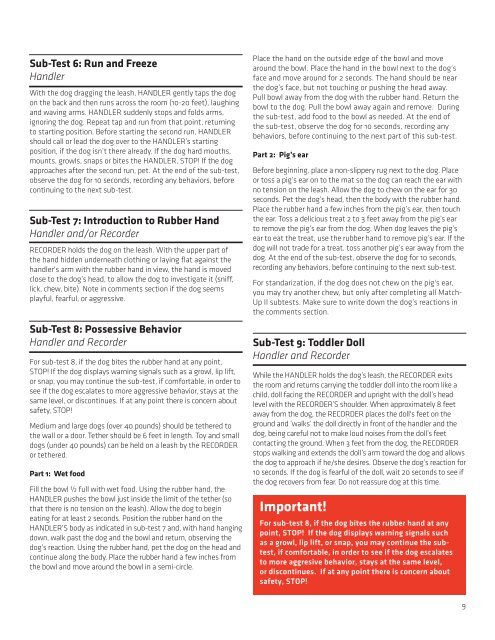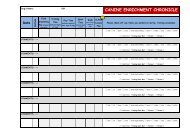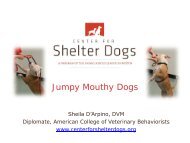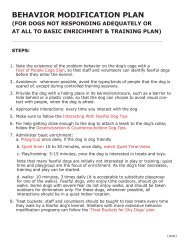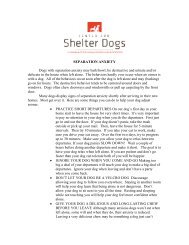Match-Up II Manual - Center for Shelter Dogs
Match-Up II Manual - Center for Shelter Dogs
Match-Up II Manual - Center for Shelter Dogs
- No tags were found...
Create successful ePaper yourself
Turn your PDF publications into a flip-book with our unique Google optimized e-Paper software.
Sub-Test 6: Run and FreezeHandlerWith the dog dragging the leash, HANDLER gently taps the dogon the back and then runs across the room (10-20 feet), laughingand waving arms. HANDLER suddenly stops and folds arms,ignoring the dog. Repeat tap and run from that point, returningto starting position. Be<strong>for</strong>e starting the second run, HANDLERshould call or lead the dog over to the HANDLER’s startingposition, if the dog isn’t there already. If the dog hard mouths,mounts, growls, snaps or bites the HANDLER, STOP! If the dogapproaches after the second run, pet. At the end of the sub-test,observe the dog <strong>for</strong> 10 seconds, recording any behaviors, be<strong>for</strong>econtinuing to the next sub-test.Sub-Test 7: Introduction to Rubber HandHandler and/or RecorderRECORDER holds the dog on the leash. With the upper part ofthe hand hidden underneath clothing or laying flat against thehandler's arm with the rubber hand in view, the hand is movedclose to the dog’s head, to allow the dog to investigate it (sniff,lick, chew, bite). Note in comments section if the dog seemsplayful, fearful, or aggressive.Sub-Test 8: Possessive BehaviorHandler and RecorderFor sub-test 8, if the dog bites the rubber hand at any point,STOP! If the dog displays warning signals such as a growl, lip lift,or snap, you may continue the sub-test, if com<strong>for</strong>table, in order tosee if the dog escalates to more aggressive behavior, stays at thesame level, or discontinues. If at any point there is concern aboutsafety, STOP!Medium and large dogs (over 40 pounds) should be tethered tothe wall or a door. Tether should be 6 feet in length. Toy and smalldogs (under 40 pounds) can be held on a leash by the RECORDERor tethered.Part 1: Wet foodFill the bowl ½ full with wet food. Using the rubber hand, theHANDLER pushes the bowl just inside the limit of the tether (sothat there is no tension on the leash). Allow the dog to begineating <strong>for</strong> at least 2 seconds. Position the rubber hand on theHANDLER’S body as indicated in sub-test 7 and, with hand hangingdown, walk past the dog and the bowl and return, observing thedog’s reaction. Using the rubber hand, pet the dog on the head andcontinue along the body. Place the rubber hand a few inches fromthe bowl and move around the bowl in a semi-circle.Place the hand on the outside edge of the bowl and movearound the bowl. Place the hand in the bowl next to the dog’sface and move around <strong>for</strong> 2 seconds. The hand should be nearthe dog’s face, but not touching or pushing the head away.Pull bowl away from the dog with the rubber hand. Return thebowl to the dog. Pull the bowl away again and remove. Duringthe sub-test, add food to the bowl as needed. At the end ofthe sub-test, observe the dog <strong>for</strong> 10 seconds, recording anybehaviors, be<strong>for</strong>e continuing to the next part of this sub-test.Part 2: Pig’s earBe<strong>for</strong>e beginning, place a non-slippery rug next to the dog. Placeor toss a pig’s ear on to the mat so the dog can reach the ear withno tension on the leash. Allow the dog to chew on the ear <strong>for</strong> 30seconds. Pet the dog’s head, then the body with the rubber hand.Place the rubber hand a few inches from the pig’s ear, then touchthe ear. Toss a delicious treat 2 to 3 feet away from the pig’s earto remove the pig’s ear from the dog. When dog leaves the pig’sear to eat the treat, use the rubber hand to remove pig’s ear. If thedog will not trade <strong>for</strong> a treat, toss another pig’s ear away from thedog. At the end of the sub-test, observe the dog <strong>for</strong> 10 seconds,recording any behaviors, be<strong>for</strong>e continuing to the next sub-test.For standarization, if the dog does not chew on the pig's ear,you may try another chew, but only after completing all <strong>Match</strong>-<strong>Up</strong> <strong>II</strong> subtests. Make sure to write down the dog’s reactions inthe comments section.Sub-Test 9: Toddler DollHandler and RecorderWhile the HANDLER holds the dog’s leash, the RECORDER exitsthe room and returns carrying the toddler doll into the room like achild, doll facing the RECORDER and upright with the doll’s headlevel with the RECORDER’S shoulder. When approximately 8 feetaway from the dog, the RECORDER places the doll's feet on theground and ‘walks’ the doll directly in front of the handler and thedog, being careful not to make loud noises from the doll’s feetcontacting the ground. When 3 feet from the dog, the RECORDERstops walking and extends the doll’s arm toward the dog and allowsthe dog to approach if he/she desires. Observe the dog’s reaction <strong>for</strong>10 seconds. If the dog is fearful of the doll, wait 20 seconds to see ifthe dog recovers from fear. Do not reassure dog at this time.Important!For sub-test 8, if the dog bites the rubber hand at anypoint, STOP! If the dog displays warning signals suchas a growl, lip lift, or snap, you may continue the subtest,if com<strong>for</strong>table, in order to see if the dog escalatesto more aggresive behavior, stays at the same level,or discontinues. If at any point there is concern aboutsafety, STOP!9


